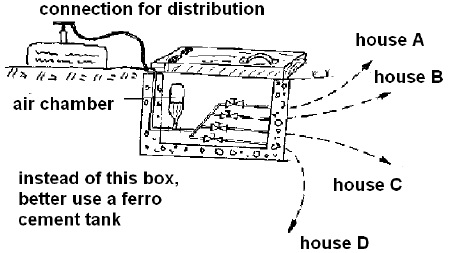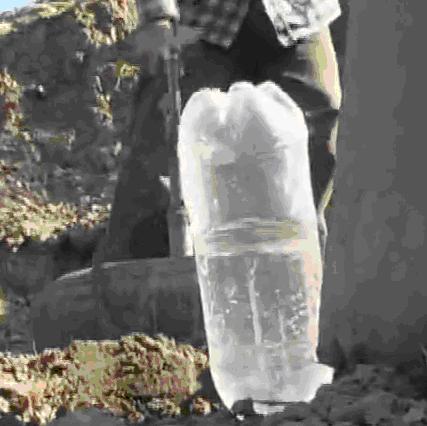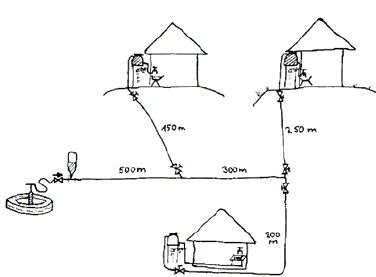Difference between revisions of "Remote Manual Pumping (EMAS)"
(→Manuals, videos, and links) |
|||
| (8 intermediate revisions by the same user not shown) | |||
| Line 1: | Line 1: | ||
| − | + | {{Language-box|english_link= Remote Manual Pumping (EMAS) | french_link= Coming soon | spanish_link= Coming soon | hindi_link= Coming soon | malayalam_link= Coming soon | tamil_link= Coming soon | swahili_link=coming soon | korean_link= Coming soon | chinese_link= 远程手动泵(EMAS)| indonesian_link= Coming soon | japanese_link= Coming soon }} | |
| − | [[Image:RemoteManualPump(EMAS).jpg|thumb|right| | + | [[Image:remote EMAS icon.png|right|80px]] |
| + | [[Image:RemoteManualPump(EMAS).jpg|thumb|right|200px|Remote manual pump showing many connections to homes. Drawing: [http://georg-ritter.info/wp/wp-content/uploads/2011/12/WATER_FOR_EVERYBODY.pdf Water for Everybody (EMAS).]]] | ||
| + | __NOTOC__ <small-title /> | ||
It is possible to create a system by which people can pump water into the faucet in their homes from a central pump. This is useful since often water sources such as small springs exist quite far away from homes. Rather than individuals having to carry water from the source to their homes, they simply go to the source to pump the water. Several houses can be connected to the same pump. The system uses an air chamber, pipes, and ferrocement tank to transport water automatically from the pump to storage tanks in the house. | It is possible to create a system by which people can pump water into the faucet in their homes from a central pump. This is useful since often water sources such as small springs exist quite far away from homes. Rather than individuals having to carry water from the source to their homes, they simply go to the source to pump the water. Several houses can be connected to the same pump. The system uses an air chamber, pipes, and ferrocement tank to transport water automatically from the pump to storage tanks in the house. | ||
EMAS is the acronym for Escuela Móvil de Agua y Saneamiento (Mobile School for Water and Sanitation), in Bolivia, whose director, Wolfgang Eloy Buchner, developed the EMAS pump in the 1990s. EMAS is not only the name of the mobile school for water and sanitation, but also a whole technical and social concept of water and sanitation which includes rain water harvesting, solar water heaters, windpower, hydraulic rams, water treatment, small tanks and sinks, a variety of hand and foot pumps, and ferrocement tanks. The aim of the technologies and systems is to achieve the necessary supply of drinkable water, and water for micro irrigation in rural and sub urban areas. | EMAS is the acronym for Escuela Móvil de Agua y Saneamiento (Mobile School for Water and Sanitation), in Bolivia, whose director, Wolfgang Eloy Buchner, developed the EMAS pump in the 1990s. EMAS is not only the name of the mobile school for water and sanitation, but also a whole technical and social concept of water and sanitation which includes rain water harvesting, solar water heaters, windpower, hydraulic rams, water treatment, small tanks and sinks, a variety of hand and foot pumps, and ferrocement tanks. The aim of the technologies and systems is to achieve the necessary supply of drinkable water, and water for micro irrigation in rural and sub urban areas. | ||
| − | ==Suitable Conditions== | + | ===Suitable Conditions=== |
The system can be used where the homes are up to 2km away from the pump. The standard type EMAS pump ejects water with a pressure up to 5 bar, which means that it elevates water up to 50 meters height. With this pressure, water can be conveyed horizontally until 2 Km, provided the dimensions of the tube are sufficient. If the distance is shorter than 500 m, pumping can be carried out with a 1/2" pipe. | The system can be used where the homes are up to 2km away from the pump. The standard type EMAS pump ejects water with a pressure up to 5 bar, which means that it elevates water up to 50 meters height. With this pressure, water can be conveyed horizontally until 2 Km, provided the dimensions of the tube are sufficient. If the distance is shorter than 500 m, pumping can be carried out with a 1/2" pipe. | ||
| − | ==Construction, operations and maintenance== | + | ===Construction, operations and maintenance=== |
| − | [[Image:Air chamber.jpg|thumb|right| | + | [[Image:Air chamber.jpg|thumb|right|200px|Using a plastic bottle as an air chamber]] |
| − | [[Image:EMAS remote.jpg|thumb|right| | + | [[Image:EMAS remote.jpg|thumb|right|200px|The set up of an EMAS system from a remote location works well. Drawing: (EMAS Water and Basic Sanitation Mobile School)]] |
The EMAS pump produces a pulsating stream. This makes it difficult to transport through a waterpipe, because it originates ram strokes and friction is highly increased. Consequently, the pulsating stream must be transformed into a continuous stream. This can be done by means of an air chamber. An air chamber can simply be a plastic bottle. | The EMAS pump produces a pulsating stream. This makes it difficult to transport through a waterpipe, because it originates ram strokes and friction is highly increased. Consequently, the pulsating stream must be transformed into a continuous stream. This can be done by means of an air chamber. An air chamber can simply be a plastic bottle. | ||
| Line 26: | Line 28: | ||
* [[EMAS pump]] | * [[EMAS pump]] | ||
* [[Small household ferrocement watertanks |ferrocement tank]] | * [[Small household ferrocement watertanks |ferrocement tank]] | ||
| − | * The air chamber can simply be a plastic bottle. | + | * The air chamber can simply be a plastic bottle. |
| − | == | + | ===Manuals, videos, and links=== |
| − | |||
| − | |||
| − | |||
* VIDEO: [http://vimeo.com/8454417 General - making pipe fittings, air chambers, etc.] This movie describes how to make different kinds of pipe fittings from PVC pipe, such as T-pieces, attaching a smaller tube to a larger one, making an air chamber, and making a hole in a plastic container. | * VIDEO: [http://vimeo.com/8454417 General - making pipe fittings, air chambers, etc.] This movie describes how to make different kinds of pipe fittings from PVC pipe, such as T-pieces, attaching a smaller tube to a larger one, making an air chamber, and making a hole in a plastic container. | ||
| − | * VIDEO: [http://vimeo.com/8454057 Spring catchment - combined with long-distance pumping.] | + | * VIDEO: [http://vimeo.com/8454057 Spring catchment - combined with long-distance pumping.] This movie shows how to combine a spring with an EMAS pump which pumps the water over a larger distance. |
| − | ==Acknowledgements== | + | ===Acknowledgements=== |
| + | * Wolfgang Buchner. [http://georg-ritter.info/wp/wp-content/uploads/2011/12/WATER_FOR_EVERYBODY.pdf WATER FOR EVERYBODY: A Selection of Appropriate Technologies to be used for Drinkable Water]. Supporting text to EMAS films, for all those who wish to improve drinkable water, micro irrigation or basic sanitation. EMAS. 5th edition, 2006. | ||
Latest revision as of 03:43, 18 October 2016
| |
|
|
|
|
|
|
|
|
|

It is possible to create a system by which people can pump water into the faucet in their homes from a central pump. This is useful since often water sources such as small springs exist quite far away from homes. Rather than individuals having to carry water from the source to their homes, they simply go to the source to pump the water. Several houses can be connected to the same pump. The system uses an air chamber, pipes, and ferrocement tank to transport water automatically from the pump to storage tanks in the house.
EMAS is the acronym for Escuela Móvil de Agua y Saneamiento (Mobile School for Water and Sanitation), in Bolivia, whose director, Wolfgang Eloy Buchner, developed the EMAS pump in the 1990s. EMAS is not only the name of the mobile school for water and sanitation, but also a whole technical and social concept of water and sanitation which includes rain water harvesting, solar water heaters, windpower, hydraulic rams, water treatment, small tanks and sinks, a variety of hand and foot pumps, and ferrocement tanks. The aim of the technologies and systems is to achieve the necessary supply of drinkable water, and water for micro irrigation in rural and sub urban areas.
Suitable Conditions
The system can be used where the homes are up to 2km away from the pump. The standard type EMAS pump ejects water with a pressure up to 5 bar, which means that it elevates water up to 50 meters height. With this pressure, water can be conveyed horizontally until 2 Km, provided the dimensions of the tube are sufficient. If the distance is shorter than 500 m, pumping can be carried out with a 1/2" pipe.
Construction, operations and maintenance
The EMAS pump produces a pulsating stream. This makes it difficult to transport through a waterpipe, because it originates ram strokes and friction is highly increased. Consequently, the pulsating stream must be transformed into a continuous stream. This can be done by means of an air chamber. An air chamber can simply be a plastic bottle.
The air chamber pipes are laid to transport water to homes with valves at each junction to control the flow of water. This can be done in several forms. Perhaps the most advisable is the one that has the form of a "star", wherein each house lays out its water pipe from the pump in a straight line. But this implies more piping and consequently higher costs. Its advantage is that you only have to go to the well, shut the correct valves and begin to pump. You don't need to walk far in order to shut the other connections.
If the straight set up is too expensive it is also possible to share the main faucet, and from there have different pipes leading to different houses. To fill the ferrocement reservoir at a given house, first you must shut the valves of the other branches, and then pump.
Maintenance
All air chambers need adequate maintenance. Water under pressure has the property of absorbing more air than when it is in its usual condition. Therefore after some time, air inside the chamber decreases, and it is not useful any more. According to the characteristics of the system, air in the chamber must be increased at given times. For this purpose, every chamber has a pneumatic valve.
All parts of the system can be manufactured locally:
- EMAS pump
- ferrocement tank
- The air chamber can simply be a plastic bottle.
Manuals, videos, and links
- VIDEO: General - making pipe fittings, air chambers, etc. This movie describes how to make different kinds of pipe fittings from PVC pipe, such as T-pieces, attaching a smaller tube to a larger one, making an air chamber, and making a hole in a plastic container.
- VIDEO: Spring catchment - combined with long-distance pumping. This movie shows how to combine a spring with an EMAS pump which pumps the water over a larger distance.
Acknowledgements
- Wolfgang Buchner. WATER FOR EVERYBODY: A Selection of Appropriate Technologies to be used for Drinkable Water. Supporting text to EMAS films, for all those who wish to improve drinkable water, micro irrigation or basic sanitation. EMAS. 5th edition, 2006.


